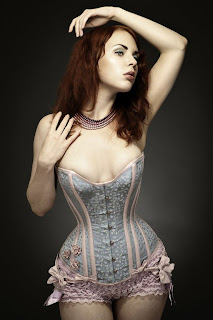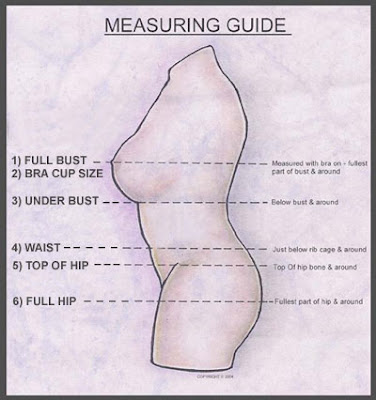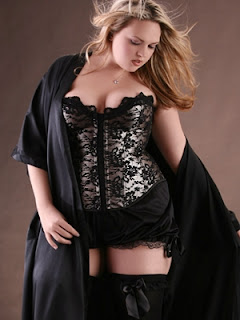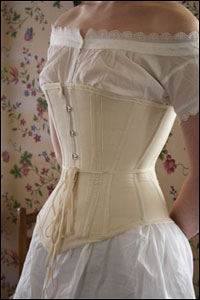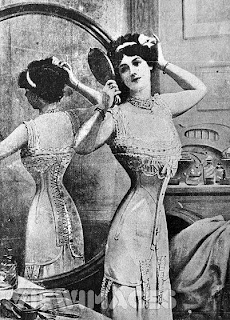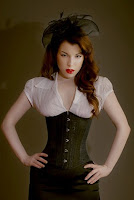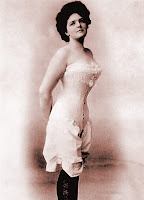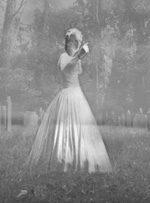“I’m one of those strange beasts who really likes a corset.” – Cate Blanchett
Yesterday in The Corset Guide: Part I, we discussed some of the reasons why modern women are still in the “corset culture” despite the stigma of corsets being symbols of restriction and oppression of women in history. Women are reclaiming their own sexuality, feminine power, and taking the stigma out of corsetry by doing it on their own terms. We also went over some key vocabulary and dissected parts of the corset to better understand the evolution of the garment into what it is today.
To review, the main types of corsets I explained were the overbust corset, the underbust corset, the straight front or “S” corset, the summer corset, and the ribbon corset. There are many other types of corsets but I chose those as a sampling for you to get you started.
Today I promised that we would learn about getting started with your own corset, share some tips, and exploring how far you might want to go in corset culture. It can be quite daunting with so many different options and things to avoid out there. I hope I can organize things enough to help you wade through all of the information.
There are three main types of women interested in corsets from what I have seen. Of course these types blend into each other in different ways but for organizational purposes, I’ve divided the types of corset women into these three groups.
Traditional
These are the women who are introduced to corsets through reenacting and living history, acting historical parts on stage or film, etc. Standards of historical accuracy might be so high that the woman will struggle to move into more modern corset styles. There will also be some difficulty getting past the idea that a corset is not just a functional piece of underwear. I was brought into the art of corsetry through Civil War reenacting and I was terrified the first time I wore a corset out in the open. To me, it was like leaving the house in just a bra and panties. Entering the art of corsetry through historical research forced upon me a level of appreciation for the engineering and construction of a good corset. They understood in the nineteenth century how to make a corset fit like a second skin. There were no standard sizes, so each corset was measured to the centimeter to fit the lady. Unfortunately there aren’t many skilled custom corset builders today and they cost a pretty penny but once you try one built specifically for your body, you’ll never want one off the rack again!
Lingerie
I think this is probably the biggest group of women who dabble in corsets. Lingerie enthusiasts may love their frilly teddies, bras and panties, but every woman I know who has a corset in her “toy box” treats it with reverence. It’s special and tends to be used on special occasions. I know a lot of brides who have worn them under their wedding dresses, for example. I also know a lot of women who’s romantic partners go nuts for a corset and they are never sorry when they try them. The lingerie enthusiasts usually begin a corset collection for every mood. You can convey everything from sweetness and virginity with pastels and lace all the way to tough as nails domination with leather, spandex, etc. Each corset has its own personality and facilitates different parts of the woman’s personality to come out, so they should all be chosen by asking, “What do I want to say with this corset?”
Fashion
The other group of women into corsets is the fashion group. These are the women who don’t necessarily know a lot about corset culture but they like the way they look, so they make them into party outfits or formal gowns. Sometimes lingerie corsets are adapted to be worn with a mini skirt or a great pair of skinny jeans. Much of the time, people aren’t even aware that they’re looking at a corset, as is the case with the satin Dolce and Gabbana dress on the left. Fashion corsets are not typically constructed with the standards of old corsets and they are usually lightly boned. Lightly boned corsets are much more flexible and not designed for tight-lacing. In the corset world, the fashion corsets are the beginner level because they are not very tight and constructed with the old standards. The beautiful hourglass shape does make any body type look great in a formal gown though, which is why they’re still so popular with wedding gowns.
No matter which of the three main groups you identify with or if you identify with all of them, none of them are going to look right if you’re not fitted properly. More importantly, if you’re not fitted properly, the corset is going to end up being very uncomfortable and will lead to cuts, abrasions, bruises and pressure sores.
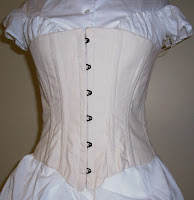 |
| Abraham’s Lady corset |
A few years ago, I went to Gettysburg for the reenactment and I had to quickly buy a corset off the rack from a shop called Abraham’s Lady. I never advise off the rack corsets in Civil War reenacting but it was a dire situation. As my friend tightened my laces, I noticed there was strange pressure under my left arm and over the front of the left side of my ribs. Within a few hours, the strange pressure points became full-blown pain. Coupled with July heat, the ill-fitted made me start to feel light-headed. I literally sat for a photograph seeing stars and starting to black out. I knew it was the corset, so I borrowed a tent and while three Confederate soldiers stood guard outside (chivalry is not dead after all), I took the loathesome corset off and put on a different bodice for that dress.
Most people think that incident is what happens to every woman who wears a corset. It’s a myth. The swooning, the romantic delicate Southern flower is simply a myth. Women of the 1860s were experts at making sure their corsets fit correctly and were built strongly so that they could raise children, do backbreaking housework, cook over hot fires, etc. I described my “swooning incident” as an example of what not to do. Never run into a shop in a hurry and grab the first corset you see. Abraham’s Lady now strongly encourages women reenactors to order custom made corsets in order to prevent injuries of this nature. My body type is nowhere near a standard size, so I can’t buy off the rack corsets without having my seamstress make serious alterations.
The corset shown here is my most recent purchase. It’s a cross between a fashion corset and lingerie even though it looks more heavy duty. Fashion corsets are very lightweight with flexible plastic boning and are not meant for tight lacing. There is no busk in this corset either, making it very flexible. This style is called burlesque because of the frills and shape. Instead of a traditional front hook and eye closure with laces up the back, this corset has a much simpler and modern zipper up the side in addition to the laces up the back.
I bought this corset off the rack in a size small. According to the size chart on the website, the size small is made to fit the measurements: bust – 32-33 A-B, waist – 23-26, hips – 32-34. On average, I’m a 32 B, a 26 waist, and a 30 hip. Those minor discrepancies in measurements might seem like nothing in regular clothes but they are enough to make your corset loose in some areas and tight in others. While my natural waist is a 26 usually, being a tight lacer means I can get my waist down to about a 22 quite comfortably. This corset is not meant to cinch you down that much, so I find that we keep pulling and pulling on the laces but it doesn’t feel tight enough even though it’s being worn right. Tight lacers often have trouble with fashion corsets feeling baggy. I doubled up the lace but it then became too short, so I had to go buy a different lace. The new lace is longer and stronger, thereby correcting most of the loose areas around the bust and hips, but I have to be careful not to be too rough on Miss Burlesque. Lacing her too tight might pop a bone because they are thin plastic. If you pop a bone, you’ll get stabbed in the ribs all night and develop a raw spot on your skin.
I might have to have my seamstress take the bust in a little bit. Your bust in a burlesque corset should be on prominent display. If you put on a burlesque corset and find that your bust is not securely pushed up, together, and not sagging or moving no matter how you jump around, then it’s too big. On the other hand, you should not feel pain or suffocation. Always take in the bust of your corset at the seams. In this case, the main seams run down the sides, so we’ll probably make adjustments under the arms where people won’t see it.
What kind of corset should you experiment with first? “Get an inexpensive one to start, with plastic boning, NOT tight lacing, to see how it feels,” advises Codie Wheeler, longtime corset wearer. “Make sure to follow the measurement guidelines. Try different styles ie: overbust, underbust. I find that the guidelines don’t work so well for me though. I have a broad chest and not-huge boobs. I find that most corset makers think that if your chest is broad, your boobs are big. My steel-boned, tight-lacing corset doesn’t fit my boobs. The boob parts are loose, even tightened so much I can’t take a breath. Waste of $75.”
Ask someone to help you take accurate measurements of your body in its natural shape. Find someone who doesn’t mind seeing you naked and never, ever try to take your own measurements. If you can’t find anyone, the lovely people at lingerie shops will be willing to help. I go through weight fluctuations sometimes and the sales girls at Victoria’s Secret are always willing to help you be certain that you are properly sized. So where should you measure your body? Here is an illustration to help you. Record the measurements in inches and centimeters. Standard sizes are done in inches but a good custom corset maker will do it in centimeters for a more snug fit.
A good place to try inexpensive, lightly boned corsets is The Fashion Corset Shop. They are not to the highest standard but they are cute, a wide variety of styles, and they are quite flexible. You never want to jump right into the steel boned hardcore tight lacing corsets, otherwise you run the risk of hurting yourself and “swooning” like I did in Gettysburg. Choose the size closest to your measurements and experiment with the different ways you can make it fit with the tightness or looseness of your laces. Go try on corsets at Victoria’s Secret or Frederick’s of Hollywood if you’re not ready to buy one yet. Keep in mind that feeling pressure around your body is normal but pay attention to any spots of pain. There should never be any pain and you should never feel like you’re not getting enough oxygen. Sexy should not equal torture (unless you’re into that kind of thing)!













